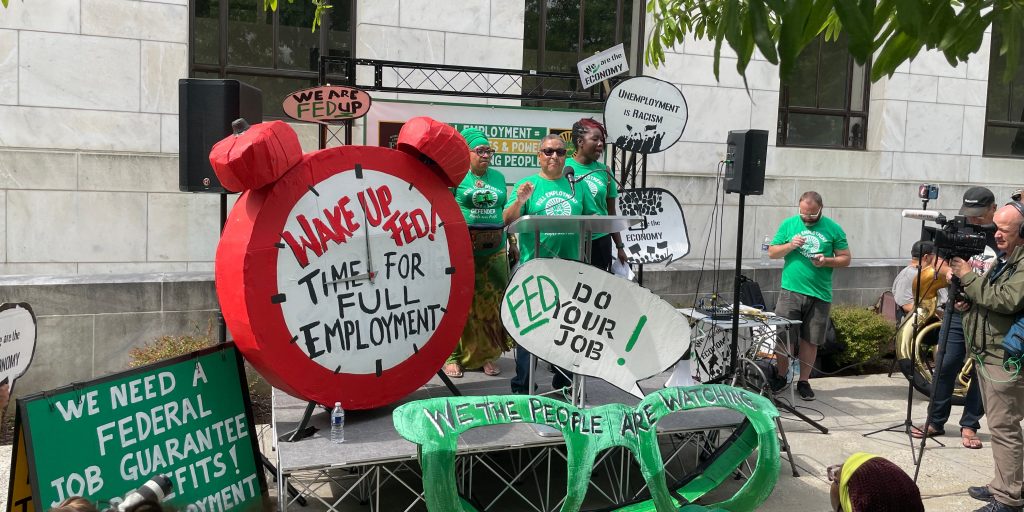- Activists staked out the Federal Reserve on Tuesday, urging officials to keep a focus on workers.
- The protest came a day before the Fed's first triple-sized rate hike since 1994 to fight inflation.
- Higher rates hurt the labor market's recovery and don't cool inflation quickly, the activists said.
The Federal Reserve is in full inflation-fighting mode, raising interest rates at the fastest pace in nearly three decades to slow the country's yearlong price surge.
A group of labor activists say that's the exact opposite of what policymakers should be doing. The Fed Up Campaign organized a cohort and protested outside the Fed with that message on Tuesday as the central bank's leaders met to decide on the next month of monetary policy. Instead, officials should keep fueling the labor market's recovery, they said.
Since 1977, the Fed has set its policies in pursuit of two goals: maximum employment and price stability. The so-called "dual mandate" is tricky to achieve. A tight labor market can lead to inflation as workers demand higher wages and businesses raise prices accordingly. Cooling high inflation with higher interest rates, meanwhile, can slow the economy down and spark widespread layoffs.
Rate hikes are the Fed's best tool for cooling inflation, but they come with the side effect of slower economic growth. So far, the tradeoff doesn't seem to be working, Lindsay Owens — the executive director of The Groundwork Collaborative — told Insider.
"We're all rooting for a soft landing, but the worst-case scenario is high prices and high unemployment, and I really do worry that we're headed there," Owens said. "We're getting the stock-market crash. We're getting the wage-growth deceleration. And we're not getting the energy prices down."
The dual mandate leaves the Fed in a perpetual balancing act. In 2022, the central bank is leaning heavily toward solving the country's inflation problem. Data published Friday showed prices soaring 8.6% in the year through May, marking the fastest inflation since 1981. The overshoot was enough for the Fed to issue its first triple-sized rate hike since 1994 on Wednesday and signal such an increase could come in July.
It's exactly what the Tuesday protesters didn't want to see. The inflation problem, they said, isn't powered by low rates, but corporate greed. Industry consolidation has allowed for companies to pass a greater share of elevated costs onto consumers through higher prices, according to a recent study by researchers at the Boston Fed.
Couple that with still-snarled supply chains and Russia's invasion of Ukraine sending oil, food, and other commodity prices sky-high, and its clear that several factors outside the Fed's control are driving inflation higher. By hiking rates aggressively through 2022, the Fed is taking power from workers when the soaring prices are not their faults, the activists said.
"Look at the way many oil companies, housing developers, and other corporations are making record profits while consumer prices go up and wages and worker benefits stagnate," Justin Rogers, an activist from New Mexico, said. "Raising interest rates may slow down the inflationary rise of the cost of consumer goods, but it won't get to the root of the problem."
A larger-than-usual rate hike is only a "symbolic resolution" to high inflation, C. Arthur Blair — a retiree participating in the stakeout — told Insider. He added that he'd rather see the Fed "not raise it" if it won't address the core drivers of rising prices.
Jerome Powell — the chair of the Fed — emphasized in a June 15 press conference that the labor market is strong enough to shoulder higher rates, and that the central bank will do what it can to bring inflation to heel. The country "cannot have the kind of labor market we want without price stability," Powell said, adding "many factors that we don't control" will play a role in deciding whether inflation cools down.
With job openings near record highs and the US still adding payrolls at a stronger-than-usual pace, slowing the jobs recovery is one of the few ways the Fed can get a hold on inflation, Powell added.
"There's a path for us to get there. It's not getting easier. It's getting more challenging because of these external forces," he said. "That path is to move demand down, and you have a lot of surplus demand, take, for example, in the labor market."
Yet not all workers have felt the benefits of today's tight labor market. While the unemployment rate for white Americans hit 3% in May, the same measure for Black Americans rose to 6%, according to the Bureau of Labor Statistics. The unemployment rate for Hispanic and Latino Americans rose to 4%.
Those racial gaps in the labor market have closed significantly since the start of the pandemic. Hitting the brakes on economic growth, however, will prematurely stop that healing and leave swaths of disadvantaged workers behind, the activists said.
"Black workers continue to reenter the labor force. The share of the Black population employed continues to rise," Jennifer Wells — the deputy director of Black Led Organizing at the policy office Community Change — said. "These are positive trends, but we have such a long way to go. And they are in that room making decisions to slow what little we have down."

